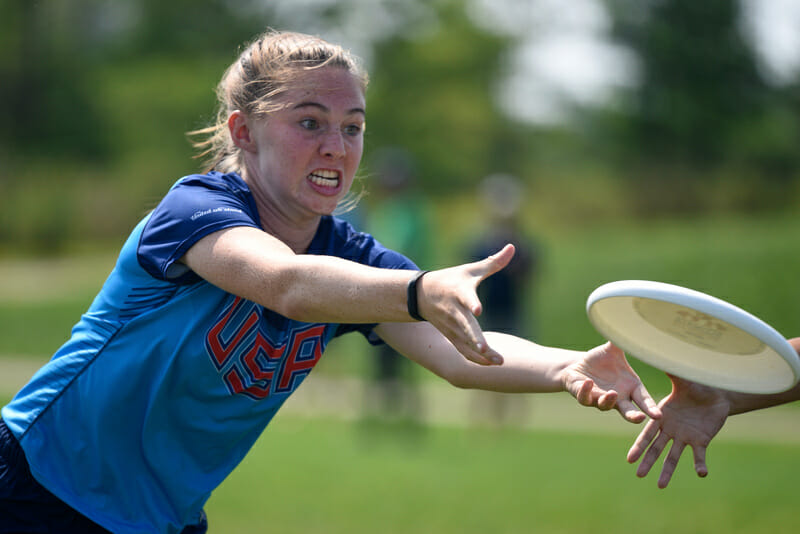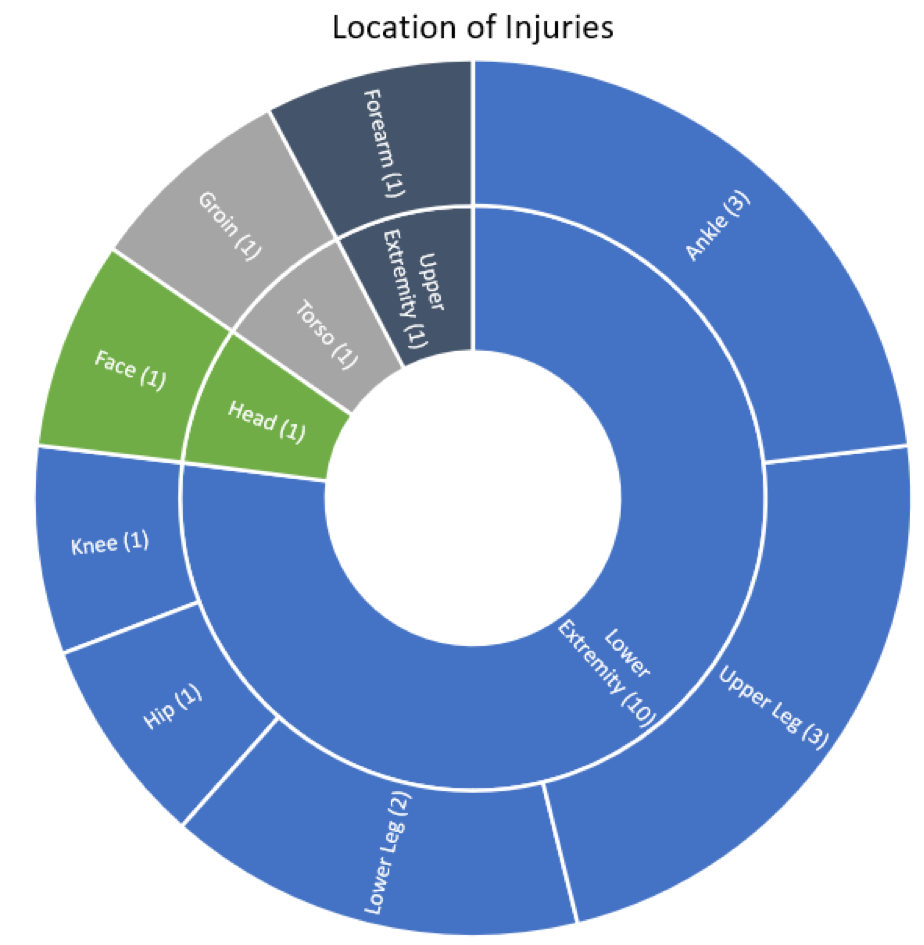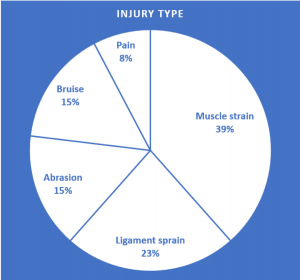An experienced research team piloted an injury surveillance program during a Washington Area Frisbee Club league in the Spring of 2018.
April 19, 2019 by Guest Author in Other with 0 comments

This post was written by guest authors Christine Collins MEd, Katharine Gray MEd ATC/L, and David Swedler PhD MPH.
Between 2011-2014 an average of 8.6 million sports-related injuries were recorded annually in the U.S.1 While thousands of injury studies have been conducted on popular sports like football, soccer, and basketball, only six studies have been published tracking injuries occurring in ultimate; almost all of which have occurred at the collegiate level.2 In order to further understand how injuries occur in ultimate and to generate prevention strategies, additional research and surveillance is needed regarding the nature of injuries at various levels of play and in diverse populations. This article reports on the first attempt to conduct injury surveillance in recreational league level ultimate.
A sports-specific injury surveillance system is vital to the creation of effective injury prevention strategies. Because injuries have not been regularly tracked through any standardized system for ultimate athletes, we initiated this project to see if it was feasible to conduct season-long injury surveillance in a regional women’s-only league.
We recruited women from the Washington, D.C. area who registered to play in the Washington Area Frisbee Club’s (WAFC) spring women’s league. We obtained permission to implement the program from league leadership and allowed individual players to opt-out. The league held weekly games for nine weeks from March through May. Athletes were divided into five teams with two captains on each. The captains were asked to collect and enter injury data for their team each week.
The architecture of the surveillance system built on that of the American Ultimate Disc League’s ongoing injury surveillance system, administered out of the University of Alabama Birmingham (UAB).3 Before the season started captains were given educational materials that detailed the method of injury data collection as well as the characteristics of common injuries seen in athletes of similar sports such as soccer and football. One member of the study team was also a participant in the league. The study defined an injury as an event that caused a player to lose playing time in a game, regardless of how much playing time was lost. This aligns with the AUDL injury definition and the 2015 USAU college injury study. Captains collected data using a paper survey that was to be completed for each injury sustained by a member of their team. This survey included information about injury location, how it was sustained, whether it was a new injury or exacerbation, and the position of the player when the injury occurred. All data was deidentified before being sent to the research team through a secure online platform at UAB.

During the 2018 spring season, eighty-three women participated in the study over the course of 36 total games. This led to 386 athlete-exposures, defined as one player participating in one game regardless of time played. In these 386 exposures, thirteen injuries were recorded, for an injury incidence rate of 33.68 per 1000 athlete exposures. There were twelve novel injuries and only one which was an exacerbation of a prior injury. No injuries were severe enough to warrant further attention from a medical professional. Therefore, while the injury rate in this league was higher than in previous studies of male and female players, none of the injuries were severe.
The majority of injuries were non-contact, with seven occurring while running, two during a solo layout, and one while jumping for a disc. The remaining three injuries occurred during a running collision with another player. Regarding the location of injury, most injuries were localized to the lower extremity – three to the upper leg, one to a knee, two to the lower leg, three to an ankle, one to the hip/pelvis area, one to the groin, one to the forearm, and one to the face. Most of the injuries were musculoskeletal, with the injuries as follows: five muscle strains, three ligament sprains, two abrasions, two bruises, and one report of pain. Players experienced increased injury incidence while playing offense and during the second half of the game. These injury trends are consistent with injuries recorded in the AUDL injury study.
Due to lower enrollment in the study and limited number of exposures, the injury results did not achieve statistical significance. However, this study establishes the feasibility of conducting an injury surveillance program at the recreational level for ultimate players. The WAFC’s women’s spring league was chosen in order to specifically highlight female ultimate athletes, a population that has been historically underrepresented in injury surveillance at large as well as in ultimate. Additionally, this league was chosen because it met one night a week in a location in which a researcher could be present.

Challenges faced with data collection included difficulty with buy-in and compliance from captains, as the system did not supply incentives (financial or otherwise) for their efforts. This was also the first-year the study was performed, so it has not yet become standard practice and could have been viewed as an additional logistical burden for the captains. This buy-in may be improved through increased promotion and advertising of the study and from increased emphasis from league leadership. As the sport of ultimate gains popularity throughout the world and a wider array of people participate, the importance of studying ultimate injuries is increasing. Only through studying when, where, and why injuries occur can organizations make changes that will increase the safety of all participants. Leagues and individual players perform better and experience safer engagement when injuries are better tracked and better understood; we hope that this study can serve as an example and precedent for future ultimate specific injury surveillance.
Acknowledgements
The research team is grateful for the guidance and input from Matthew Hess MD and Eugene Brabston MD, who were integral in bringing the study to fruition. Ms. Collins’ time was supported through the University of Alabama – Birmingham. [IRB-300001193 – Injury Surveillance in Women’s Ultimate (Frisbee)] No other funds were used for this research. The authors report no conflicts of interest.
For more information about this study or setting up an injury surveillance program in your league, feel free to contact the research team at [email protected]. We would love to see expanded research into the sport of ultimate and injury prevention and are happy to share our experience and collaborate with others.
Hedegaard, Holly, et al. Sports- and Recreation-Related Injury Episodes in the United States, 2011–2014. National Health Statistics Reports, 18 Nov. 2016, www.cdc.gov/nchs/data/nhsr/nhsr099.pdf. ↩
Akinbola M, Logerstedt D, Hunter-Giordano A, Synder-Mackler L. Ultimate Frisbee injuries in a collegiate setting. Int J Sports Physical Therapy, 2015; 10(1): 75-84. Swedler DI, Nuwer JM, Nazarov A, Huo SC, Malevanchik L. Incidence and descriptive epidemiology of injuries to college ultimate players. J Athl Train. 2015;50(4):419-425. McElveen M, North T, Rossow A, Cattell M. Injury rates in intramural sports. Rec Sports J. 2014; 38: 98-103. Yen LE, Gregory A, Kuhn JE, Markle J. The ultimate Frisbee injury study: The 2007 Ultimate Players Association College Championships. Clin J Sports Med. 2010;20(4): 300-305. Reynolds KH, Halsmer SE. Injuries from ultimate Frisbee. Wisc Med J. 2006; 105(6): 46-50. Marfleet P. Ultimate injuries: A survey. Br J Sports Med. 1991; 25(4): 235-240. ↩
Hess M, Swedler D, Collins C, Brabston E. “Injury Rates and Characteristics in Professional Ultimate (Frisbee).” Journal of Athletic Training. In Press. Summer 2019 ↩